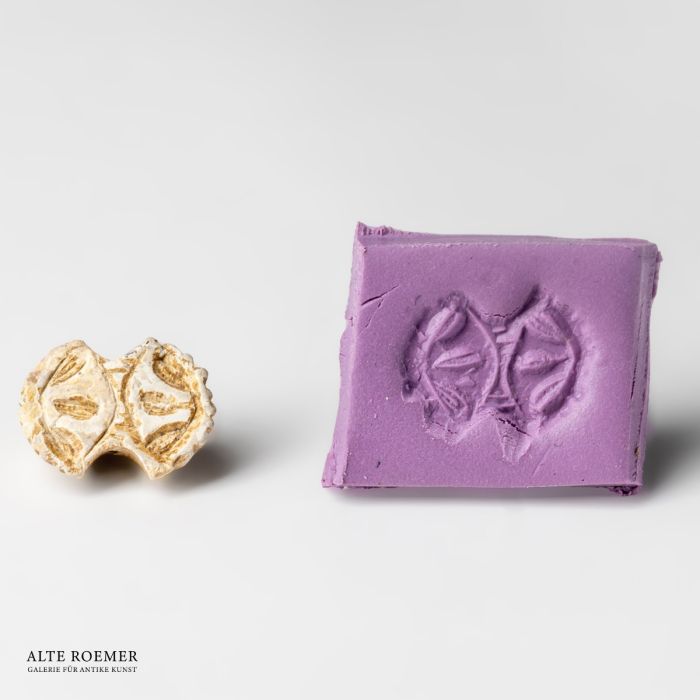Minoan shell-shaped seal
Price: on request
Sold
Object number
AR3520D
| Object: |
Minoan shell-shaped seal
|
| Material: |
White paste with beige slip.
|
| Period: |
Early Minoan II to Middle Minoan IA, C. 2700 BC to 1900 BC, Aegaen Bronze Age. |
| Description: |
Minoan seal in the form of an elliptical, flat dome, symmetrically tapered along the long sides. Fine longitudinal grooves on the upper side are reminiscent of a shell. The base, on the other hand, resembles a figure-eight shield - a shape that would appear more frequently in the Aegean in later centuries. A through hole across the waist allowed the seal to be threaded. The flat underside serves as a stamping surface. The impression is mirror-symmetrical to the central axis and shows three leaves along an arcuate line on the outside opposed by an arcuate line on the inside.
|
| Background: |
The Minoan seals of Crete offer a key to the Bronze Age world of the Minoans, whose culture flourished in the 3rd and 2nd millennia BC. These small, artfully engraved objects not only served as practical markings for goods and possessions, but also reflected religious ideas, social structures, and aesthetic principles. Glyptics developed into an independent art form on Crete. Animal depictions, cult scenes, and abstract symbols were carved into materials such as steatite, jasper, or agate. Compared to seals from Egypt or Mesopotamia, the Minoan pieces demonstrate remarkable originality, despite the close Mediterranean trade relations. For collectors and researchers, these seals are far more than artifacts. They are windows into a lost world whose secrets have aroused curiosity and the spirit of discovery since the time of Sir Arthur Evans. |
| Dimensions: |
Length 13.9mm, width 10.3mm, height 7mm. Hole diameter 1.7mm.
|
| Condition: |
Surface slightly chipped, otherwise perfectly preserved.
|
| Provenance: |
Acquired by us in 2023 on the German art market. Previously in the Grumach family collection. The founder Dr. Ernst Grumach acquired the seal before 1968. Dr. Ernst Grumach (1902–1967) was a broadly positioned scholar specializing in classical philology, Egyptology, and linguistics. He placed an emphasis on the proto-writings of the Bronze Age Aegean. His collection of Cretan seals was created with a keen eye for significant pieces. It was studied by Ingo Pini, presumably in the 1960s during Dr. Grumach's lifetime, and later published with funding from the German Ministry of Education and Research. |
| Publications: |
Described in detail and illustrated in Ingo Pini, Corpus der minoischen und mykenischen Siegel (CMS), volume XI Kleinere europäische Sammlungen, p. 84, no. 75 (Akademie der Wissenschaften und der Literatur Mainz, 1988). Digitized in Arachne, the central object database of the German Archaeological Institute, Arachne-ID 1160106. |
| Literature: |
Relevant publications by or about Dr. Ernst Grumach, E. Grumach, Bibliographie der kretisch-mykenischen Epigraphik (Berlin and Munich, 1961). Festschrift for the 65. birthday of Ernst Grumach (posthum), W. C. Brice, Studien zur Geschichte und Epigraphik der frühen Aegaeis (Berlin, 1967). |
| Authenticity: |
We unconditionally guarantee the authenticity of every artefact, all items are subject to our lifetime return policy on authenticity.
|


